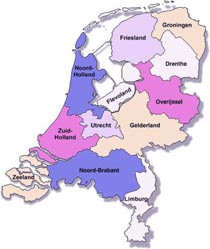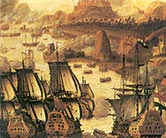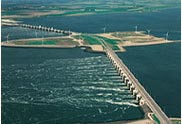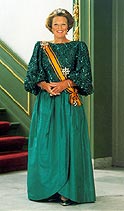| (insert your NIE or newspaper logo here) |
Weekly Online LessonOnline Lesson ArchiveGrade Level: 7-12
|
Royal Rejection In The Netherlands
 The Dutch Royal Family both celebrated and bemoaned the wedding of the queen's second son, Prince Johan Friso, which took place on Saturday, April 24, 2004.
The Dutch Royal Family both celebrated and bemoaned the wedding of the queen's second son, Prince Johan Friso, which took place on Saturday, April 24, 2004.
In the moment of speaking two words, "I do," to his bride, Mabel Wisse Smit, the prince simultaneously committed himself to marriage and rejected the Dutch throne.
By law, the Dutch government must approve marriages proposed by royals in the line of succession. To receive approval, the engaged couple must disclose details from their past, including the extent of personal relationships.
Last October, the government announced that it believed "The couple had provided information that was not complete and not correct, which has harmed the confidence (of the government)." At issue was the bride-to-be's relationship with a known, now deceased, drug lord, which the government says was more extensive than she admitted.
Following that announcement, Prince Johan Friso and his bride decided to get married anyway. Although he is no longer in line for the throne, he will keep his title as prince and his children will be dukes and duchesses. His wife will remain a commoner.
Like several other European countries, the Kingdom of Netherlands (its formal name) still derives much of its national identity from its monarchy, which extends back hundreds of years and over several generations. Even before the monarchy, though, more fundamental forces -- including trade, war, and religion -- shaped the area into a distinct, sovereign region.
This week you'll journey to the land famous for tulips, wooden shoes and windmills -- to meet the modern royal family and explore the nation's history, traveling back as far as 50 B.C.
A Turbulent History in the Low Countries
 Today, the Netherlands consists of 12 distinct provinces (not including its dependent territories of
Aruba and Netherlands Antilles).
Today, the Netherlands consists of 12 distinct provinces (not including its dependent territories of
Aruba and Netherlands Antilles).
But how did this region become defined as such? To answer that question, visit the Dutch Ministry of Foreign Affairs to investigate the History of the Netherlands for yourself.
As you'll soon discover, these boundaries took shape only after centuries of power shifts. During the era 50 B.C. - 400A.D., for example, the region was part of the original Roman Empire until the empire weakened and Germanic tribes assumed control.
Click More Info at the bottom right of the page to learn more about this time period and successive eras. Click back to return to the timeline.
Continue browsing through time periods in the Formation of the Netherlands: 50 B.C. - 1588 A.D. section. Follow which tribes and individuals controlled the region as a whole or parts of the region through the ages. How did religion influence the government and society?
Now move on to the next era, The Dutch Republic at war: 1568 - 1813. What major event happened in 1588? Why was the United East India Company, setup in 1602, so important to the republic's future?
Also learn more about the century-long Golden Age. What type of citizen composed the "regent class"? In what ways did they heavily influence the republic's growth? Why do you think the arts also flourished during this period?
 How did The
War of the Spanish Succession affect life of the Golden Age? What happened during The Napoleonic Era?
How did The
War of the Spanish Succession affect life of the Golden Age? What happened during The Napoleonic Era?
Following Napoleon's defeat in the Netherlands, William Frederick becomes King William I and attempts to unite southern and northern regions into the Kingdom of the Netherlands. What actions did the king take to resolve the two regions' differences? Why did the king ultimately have to accept Belgian independence?
Belgium's independence led to another significant event in the Netherlands: Constitutional reform. What events elsewhere in Europe fueled this major overhaul?
Before leaving this era, find out how The Dutch East Indies became a strong influence in Dutch economy. How did the idea of progress and the development of technology play into this?
Read how the nation's two dominant religions, Catholicism and Protestantism, influenced important social and political issues such as The 'school conflict', and how industrialization shaped the country during The regency of Queen Emma.
Like other European countries, in addition to internal unrest, the Netherlands had to contend with World War I and The Second World War. How were Dutch citizens and their government affected by these wars?
 Along with military conflicts, the Low Countries faced natural disasters as well, like in 1953 when the Dutch struggled against the waters. How did this event affect the nation's economy? How did the government respond?
Along with military conflicts, the Low Countries faced natural disasters as well, like in 1953 when the Dutch struggled against the waters. How did this event affect the nation's economy? How did the government respond?
Now browse through The last decades of the twentieth century, starting with the political changes of 1967. More political changes occurred in 1980, with the abdication of Queen Juliana and the investiture of Princess Beatrix to the throne.
Also, discover how the Christian democrats and other parties shaped Dutch politics and policies over the next decade. Then investigate the "polder model" of 1996. How does this model fit the Dutch lifestyle? What role did the "purple" coalitions play in the implementation of the model over the next five years?
The Royal House
 Now step into present-day Netherlands, and into the Dutch Royal House. Click Navigation on the top right of the page, and choose The monarchy in the menu.
Now step into present-day Netherlands, and into the Dutch Royal House. Click Navigation on the top right of the page, and choose The monarchy in the menu.
Read the overview. What does "constitutional monarchy" mean? What's the difference between the royal house and the royal family? Is Prince Johan Friso a member of one or both? What are the relationships between the King, the Cabinet ministers, and Parliament?
Learn more about the royal house by reviewing the Investiture ceremony and the regalia section, as well as the pages explaining the Coat of arms and the royal standard and the Finances of the royal house. Why do you think the National Anthem includes historical references to rulers and historical events?
Next, meet The Queen and the members of the royal house, starting with the Queen. Continue meeting the royal house members with Prince William-Alexander, first in line to succeed the throne, and his youngest brother, Prince Constantijn, second in line, and any others you'd like to learn more about.
How has the education, military training, social activities, etc. contributed to each individual's strength and expertise? How do you think these individuals help maintain the power and popularity of the Dutch monarchy?
To complete your visit with the Dutch Royal House, make sure to take a tour of the Royal Palaces. Here, you can browse through panoramas of the Huis ten Bosch Palace, the Noordeinde Palace and Royal Archives, and the Royal Mews. In what ways do the rooms of these palaces reflect the history of this nation?
Newspaper Activities
Browse issues of Targetnewspaper for stories about the Dutch government or law, or Dutch history or culture. How does the news relate to the history of the Netherlands? How does it relate to the Dutch lifestyle or viewpoint? Does the news change the relationship of the royal house and parliament in any way?
© Copyright 2004
Learners
Online,
Inc.
